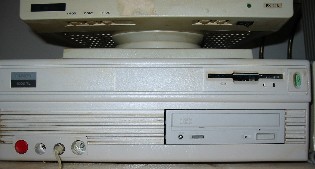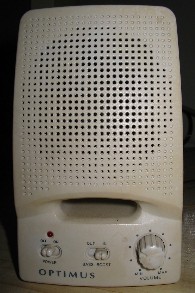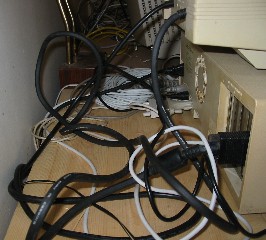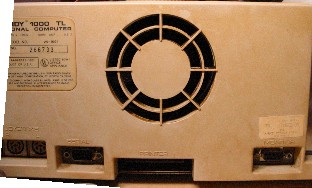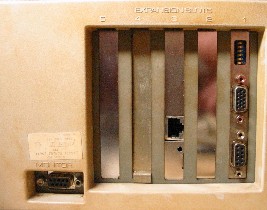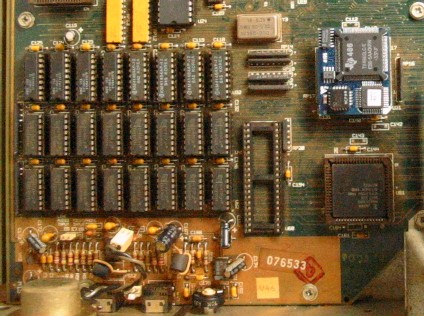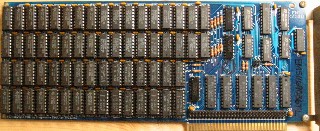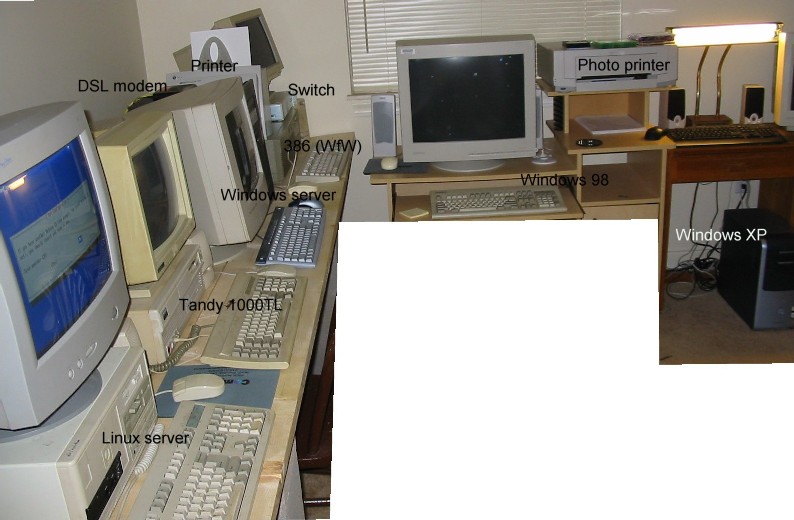Tandy 1000TL PicturesHere are some pictures of my Tandy 1000TL. You can click on any image to see a larger picture. Left: DeskMate 3.05 with Home Organizer. The monitor is a Kenitec PX-14S. This is a basic 15� color VGA monitor, with a maximum resolution of 640x480, which is fine since that is what my VGA card supports anyway. This monitor was a gift. It has smaller dot pitch than the Tandy VGM-220 that it replaced and which I still have. The mouse is a standard Microsoft serial mouse. It plugs into the built-in
serial port. It was a gift also. The CD-ROM drive is a
Pioneer DR-U32X.
This is a 32-speed SCSI CDROM drive. To play CD�s on it, I connect my speakers
to the plug in front, since the Tandy sound chip doesn�t have a CD audio plug.
This drive cost $15 on eBay. I have Optimus external speakers.
These speakers are good since they have bass boost built in. Speakers like these
cost $10-15. Even better would be speakers with adjustable bass and treble. It
is good that they have volume control, at least, since the volume control knob
on the front of my Tandy is broken off (see front panel view above). The printer port is a card-edge connector, also nonstandard. You need a special cable to connect it to a printer, and there were different types of cables depending on whether you were connecting it to a Tandy printer or a standard one. I have the cable for Tandy printers, but my old DMP-132 has died and gone to printer heaven. The built-in video uses a 9-pin D-sub connector that works with both mono TTL
and CGA monitors. I have a mono TTL to use with it, but I'm using VGA instead at
the moment. With a mono TTL monitor, the video is compatible with Hercules. With
a CGA monitor, it is compatible with that, or with PCjr, and there is an
additional 640x200x16 mode that is specific to the Tandy 1000SL/TL/RL series. The Tandy uses special joysticks with 6-pin DIN connectors. The joysticks are
standard, only the connector is different, so they work with any PC game. One
thing, though: the built-in DAC chip will not work with joysticks enabled (games
can still use the 3-voice circuitry). There are 5 8-bit slots in this machine, and all of them are filled. The card
in the middle is the network card. The one at the right is the video card - note
the DIP switches. This card is switchable for either an 8- or 16-bit slot, or
for either EGA or VGA mode (note also the connectors for both monitor types). The hard drive is a Conner CP30540, an old SCSI drive originally pulled from a Sun server. This is a 520MB drive, of which 500MB is usable in my Tandy. I am still using Tandy DOS 3.3 (uses less RAM than later versions), which has a maximum partition size of 32MB, so this drive is split into 16 partitions, C: and E: through S:. Right now I am only using partitions up to J:, so I have lots of space left. This drive was about $10 on eBay, plus shipping. The floppy drive is a Samsung SFD-321B 1.44MB floppy drive. This is a standard 1.44MB floppy drive. I got it for $10 at the computer store down the street. The eject button fits fine through the front of the case (see front panel view, above), so I didn�t have to cut a hole in the front of my Tandy to use the drive, as sometimes happens. The Tandy has a built-in floppy controller, but it uses non-standard low-density drives that draw power through the data cable. Those drives are to find nowadays. I am using an add-on floppy controller (see below). Anyway, it is good to have a high-density drive, since you can't find low-density disks any more either. The Tandy DOS Format command can't
deal with this drive, so I'm using a third-party format program. There is nothing under the drive bracket (the motherboard is L-shaped). There are 3 rows of 8 64kx4 120ns DRAM chips. The four on the top left constitute the 128k upgrade, which cost $6 back in 1993. Nowadays, the chips would probably cost about the same but be much harder to find. The upgrade increases RAM to 768k, of which 128k is used by the onboard video controller, leaving 640k for DOS. My new Windows XP machine also allocates video RAM from system RAM using the onboard controller - funny how everything old is new again. At top right, the 286 chip has been replaced with an
Improve
Technologies Make-It 486 processor module. I bought this online for $40, just
recently. You can�t get these any more, don�t even ask, I was amazed I found it,
it was the last one in stock. This chip enables
Tantrakr to play my favorite
.S3M at 19,830Hz, as opposed to 6600Hz with the old 286, so I got about a
200% speed increase (according to the Tantrakr �benchmark� :-) ). I have a 287
math coprocessor, but I had to take it out (see empty socket) since it was
incompatible with the 486 module. The box says the upgrade gives a "performance boost of 200%, 300%, even 400%
or more." As noted, I get a 200% increase. I think it must be talking about
running 32-bit code when it talks about more than that. I bought this
card many years ago; the guy I bought it from had used it in a BBS system
(remember those?). Don�t remember what I paid for it - Tandy used to sell these
for the 1000's. I wrote a 4.x driver for it since MicroMainframe wanted $50 for
theirs at the time, and I thought that was too much to pay (you can get
my driver
from
my FTP site). This card has worked like a
charm since. It has 2MB RAM on it, which is the most it will hold, but there is
a connector on the bottom for a daughterboard that holds 2MB more. I don't have
the daughterboard, though. This card came in a box of mixed hard drive, floppy drive, tape, and VGA controllers I bought on eBay for about $20. It works in the Tandy because it has a built-in BIOS, and because of a program I wrote for AUTOEXEC.BAT which disables the built-in floppy controller. Without NOFLOPPY.COM, this card would not work because of an I/O port conflict with the built-in controller (the BIOS will not disable the built-in floppy controller, so you have to do it with a program). This card uses
standard floppy drives and cables, which as noted above is good since you can�t
buy Tandy-style floppy drives any more. I bought this card online recently for $15. The software for it I downloaded separately. I think SCSI is a good way to go with older machines, since you can still get peripherals for it, and it can save expansion slots - instead of separate hard drive and CD-ROM drive controllers, I only need this card. The ASPI driver for this card (needed for peripherals other than a hard
drive) requires at least a 286. I think I
bought this out of a bin at Computer Renaissance for a couple bucks, but it was
a while ago. This card works in either an 8- or a 16-bit slot, with either an
EGA or a VGA monitor; DIP switches on the back determine its mode. When it is in
a 16-bit slot, it supports up to 1024x768 in 16 colors, but in an 8-bit slot it
is just basic 640x480 VGA, which is fine.
This card was one
of a set of 5 I bought from my old employer for about $10. It is a 16-bit card,
but it works fine in an 8-bit slot (it requires at least a 286 processor). I
downloaded the packet driver for it off the Internet. This is a 10Mbps card. I include this because I can't count the number of times I have heard it said that "DOS can't access a Windows network." Well, obviously it can. You need to get Microsoft Client 3.0 for DOS; get Disk 1 and Disk 2. MSClient came with an NDIS driver for my Ethernet card, so I didn't need to find one. If your server is running Windows Server 2003, you will need to make a few changes to the Default Domain Controller security settings as well. One drawback to Microsoft networking is that it takes 190kB of RAM - outrageous. I used freeware programs Ask and Drvinst to make an AUTOEXEC.BAT file that asks me what things I want to load and then loads only those options (i.e., Microsoft networking, NFS, packet driver, CD-ROM, mouse). So I only load Microsoft networking when I actually want to access shared files on the server or print to the network printer.
I have too many PC's :-D! In addition to accessing the printer and the Windows server, the Tandy can access files on the Linux server via NFS (using the TSoft NFS client). It could also access folders shared by the WfW, Windows 98, and Windows XP machines. It can share the DSL modem using its packet driver and browse the Web with Arachne. The printer is an HP LaserJet 1100; there is a WordPerfect 5.1 driver for it, or programs such as DeskMate can print to it using their LaserJet drivers. Only Windows 98 can access the photo (color) printer, so if I wanted to print something there from the Tandy I would have to copy it over first. Go back to Tvdog's Home Page.
|
